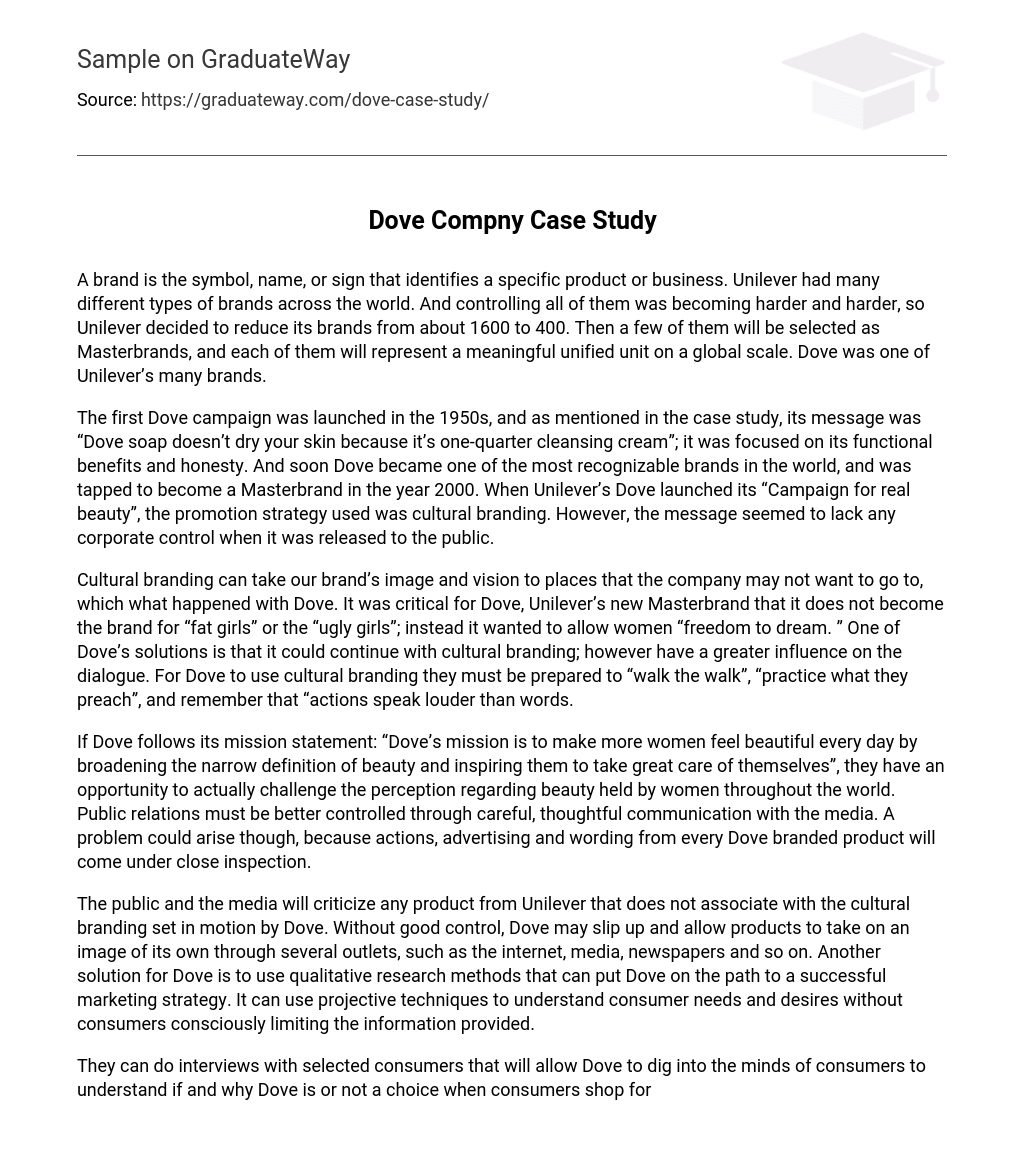A brand is an identifying symbol, name, or sign for a product or business. Unilever had numerous brands globally, but managing them all became increasingly challenging. Consequently, Unilever made the decision to decrease its brands from around 1600 to 400. The plan involved selecting a few brands as Masterbrands, each representing a significant unified entity on a global level. Among Unilever’s vast array of brands, Dove was one of them.
The initial Dove campaign was introduced in the 1950s, and according to the case study, it emphasized that “Dove soap doesn’t dry your skin because it’s one-quarter cleansing cream,” highlighting its functional advantages and commitment to transparency. This approach led to Dove’s widespread recognition and eventually resulted in its designation as a Masterbrand in 2000. When Unilever’s Dove launched its “Campaign for real beauty,” it employed a cultural branding strategy. Nevertheless, upon its public release, the message appeared to lack corporate oversight.
Dove experienced a situation where cultural branding had the potential to lead our brand’s image and vision in unintended directions. It was crucial for Dove, as Unilever’s new Masterbrand, to ensure it did not become associated with negative labels such as “fat girls” or “ugly girls”. Instead, Dove aimed to empower women and give them the freedom to dream. One approach Dove considered was to continue with cultural branding but exert greater influence on the conversation. To successfully implement cultural branding, Dove needed to align their actions with their words and recognize that actions have a stronger impact than mere statements.
If Dove adheres to its mission statement of expanding the limited definition of beauty and encouraging women to care for themselves, they can potentially challenge societal views on beauty. However, it is crucial for them to manage public relations effectively by engaging in thoughtful and controlled communication with the media. It is important to note that any actions, advertisements, or wording associated with Dove products will be closely scrutinized.
The public and the media will criticize any product from Unilever that deviates from the cultural branding established by Dove. If Dove does not have proper control, its products may unintentionally develop their own image through various channels, including the internet, media, and newspapers. An alternative solution for Dove is to employ qualitative research methods, which can guide them towards an effective marketing strategy. By utilizing projective techniques, Dove can gain insights into consumer needs and desires that may not be revealed through conscious consumer feedback.
Dove can conduct interviews with specific consumers to gain insights into their thoughts about whether or not Dove is a preferred choice when they shop for these products. Participant observation in the field can provide opportunities for Dove to interact with consumers and observe their behaviors over time. However, the challenge with qualitative research methods is that they fall under the category of a “soft science,” lacking quantitative data to support the obtained results. The outcomes from projective techniques, interviews, and participant observations do not yield definite solutions for the marketing department.
To maximize the effectiveness of cultural branding, Dove should combine it with exceptional qualitative research. The successful marketing of the new line of Dove products will greatly benefit from this integration. Before engaging in cultural branding, Dove must first conduct thorough qualitative research to comprehend consumer motivations. To counteract the limitations of subjective analysis, Dove should employ comprehensive and precise qualitative research methods. While projective techniques may be less beneficial, interviews offer a valuable and clear understanding of consumer perspectives.
By delving into the reasons behind consumers’ choices, particularly if they prefer another product over Dove, we can gain valuable insights. Conducting participant observation in target markets is crucial for acquiring data for a significant analysis. It is important to comprehend why consumers opt for certain choices in specific situations, as individuals might not always be aware of their own behavior. Observations allow us to investigate these factors. Subsequently, Dove can merge this freshly collected data with previously discovered information regarding women’s perception of beauty.
The launch of the semi controlled cultural branding campaign will commence. The “real women” firming campaign and the “Hates her freckles” advertisement will be retained. It is crucial for all Unilever products and brands to align with the marketing message throughout the campaign. A single error, such as through the Axe brand, can significantly damage the campaign, as Axe primarily advertises through sex and beauty. Authenticity is vital for our message. Some reviews of the Dove Evolution video advertisement on YouTube criticized Unilever, stating that it promotes a false message in its products, as Axe degrades beauty while Dove focuses on enhancing the appearance of average women. Others pointed out that this campaign neglects the male perspective, which can also lead to issues since men also use their products. However, there were also supportive reviews acknowledging Dove’s positive work. Therefore, Dove must embody its mission statement through every word and action to maintain honesty about its efforts to enhance the natural beauty of women.
Dove should increase its online presence by engaging with platforms like YouTube and blogs. They should promote the empowerment of all women and prioritize their well-being, as this will ultimately benefit the company. Furthermore, Dove should incorporate the male perspective in their campaign by featuring men in their advertisements and working towards enhancing both men’s and women’s self-esteem. If Dove follows these strategies and implements them effectively, they will be able to launch an authentic and successful campaign that garners trust and promotes beauty inclusivity.





